Île de Gorée. It was the thing that immediately intrigued me when I looked at a map of Dakar – destination of the 2012 trip of the Negotiating Equity project. It looked like a nice little island, but I quickly discovered to the contrary that the island is a symbol of slave trade and a memorial to the African diaspora. It serves as a reminder of human exploitation and as a sanctuary for reconciliation. As such it is on the UNESCO World Heritage list (1).
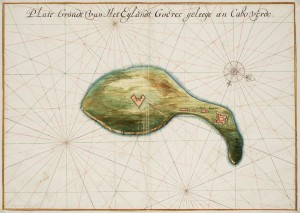
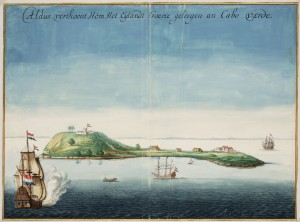
National Map Collection, Johannes Vingboons, 1665: “Plate grondt van het eylandt Goeree geleege an Cabo Verde” & “Aldus verthoont hem het eylandt Goeree geleegen an Cabo Verde “
Gorée. The Dutch gave it its name, although they weren’t the first Europeans to set foot on its shore. Between 1444 and 1446 the Portuguese set up a trade post on the island (2), which provided a safe haven for further explorations towards the Far East. The Dutch fought over it with the Portuguese several times and in 1617 they finally took it over (3). At the time of the Anglo-Dutch wars, the Dutch lost the island to the British around 1664. Soon afterwards, in 1677, the British lost it to the French. The island had been in French hands, apart from short periods of British occupation, until the independence of Senegal in 1960.
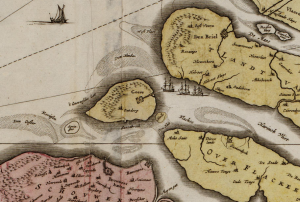
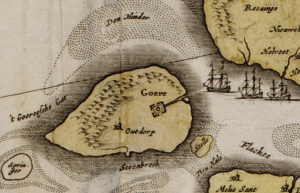
Map Collection University of Amsterdam, Joannes Janssonius, 1625: Zeelandia Comitatus [two details]
Apparently, the Dutch named the island after the Dutch island Goeree, part of Holland, one of the provinces of the Republic of United Netherlands. For a good reason: naming things is making things your own. It places the new in perspective of the familiar. It draws the unknown into the frame of the known, where it can be dealt with. It could be a way of warding off the threatening powers of the unknown. In case of naming places, as opposed to things, it becomes even more a political act and – not surprisingly – a common practice among explorers, colonizers or occupiers. One example of which is indeed Île de Gorée. Were there people on the island before the Portuguese set foot on it? What was its name before the Dutch put their mark on it?
Still, why Goeree, of all possible Dutch names? Because the ships that conquered it really came from Holland and wanted to show that by choosing a name from their region? Or because its function? The name Goeree is derived from ‘goede rede’, which means ‘roadstead’, a sheltered offshore anchorage area for ships. ‘Rede’ has another meaning as well, ‘reason’, in a way still an anchorage area, not for ships but for thoughts. For sure, both Goeree and Gorée share the particular characteristic of providing a sheltered anchorage for ships. What about the anchored thoughts?
Gorée. It could be named after its function and not necessarily after a particular Dutch island. And if it is, perhaps more factors played a role than function alone, some details of the surroundings or perhaps a similarity in shape?
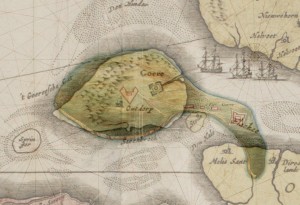
Maybe not. The above picture makes the differences in shape very clear. It shows two layered shapes, the contour lines of which are more dissonant than consonant. The disharmony in shape seems to reflect the rough historical ties between the two places. Would that historical dissonance still be noticeable? With other senses than just the eye? Can we perhaps hear traces of the relationship between the two places? Traces of the anchored thoughts? To find that out, I like to record the environmental sounds and noises, once on the island of Goeree and once on the island of Gorée. Those recordings could be used as two voices in one composition. It could result in a sound piece where Gorée and Goeree each sing their own particular melody and at the same time are tied together in a compositional structure. As they are by name and history.
(1) http://whc.unesco.org/en/list/26
(2) A. van Wickeren, Geschiedenis van Portugal en de Portugezen overzee, Part 2
(3) R. Paesie, Lorrendrayen op Africa, PhD thesis, University of Leiden, 2008